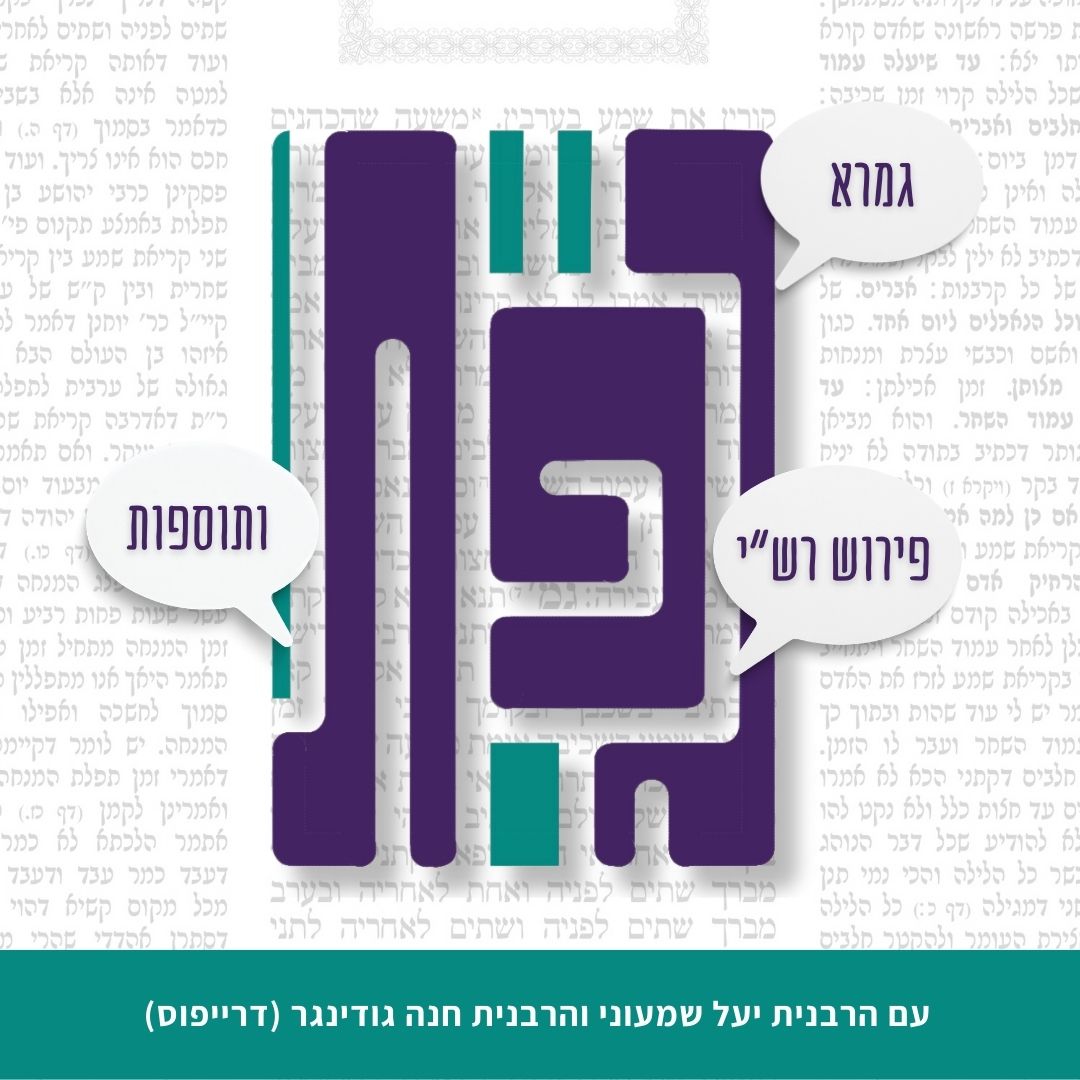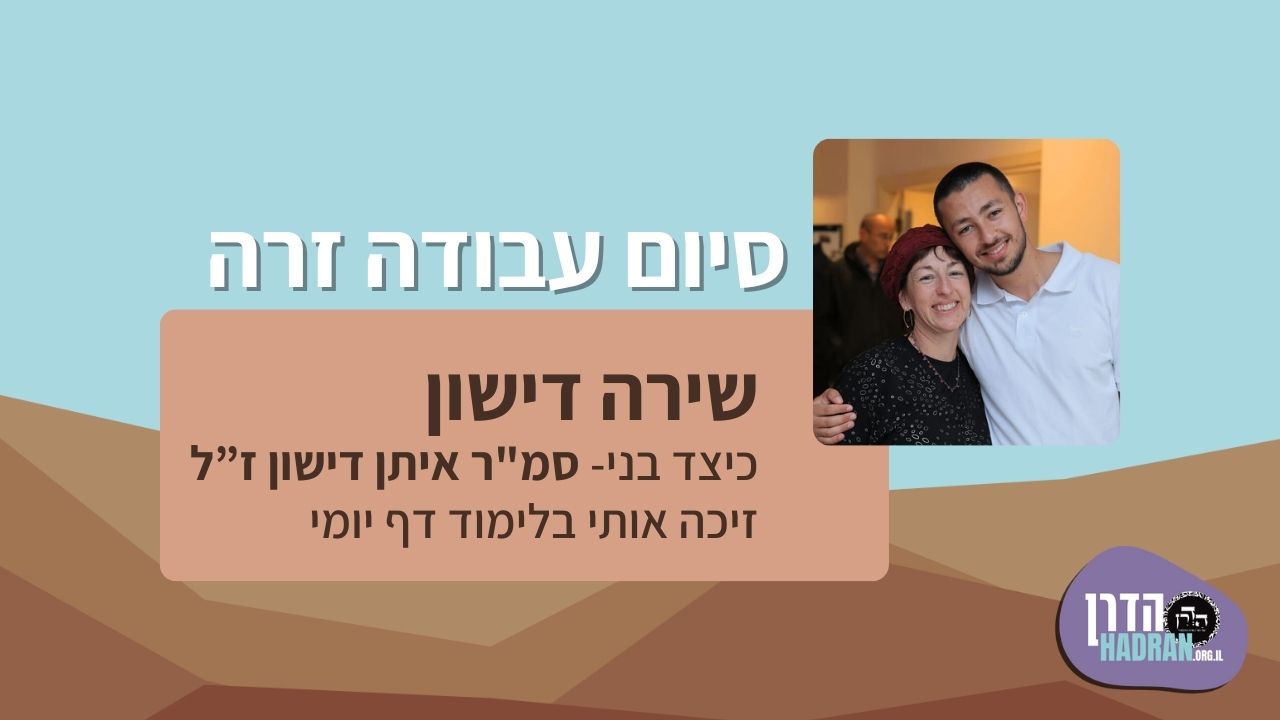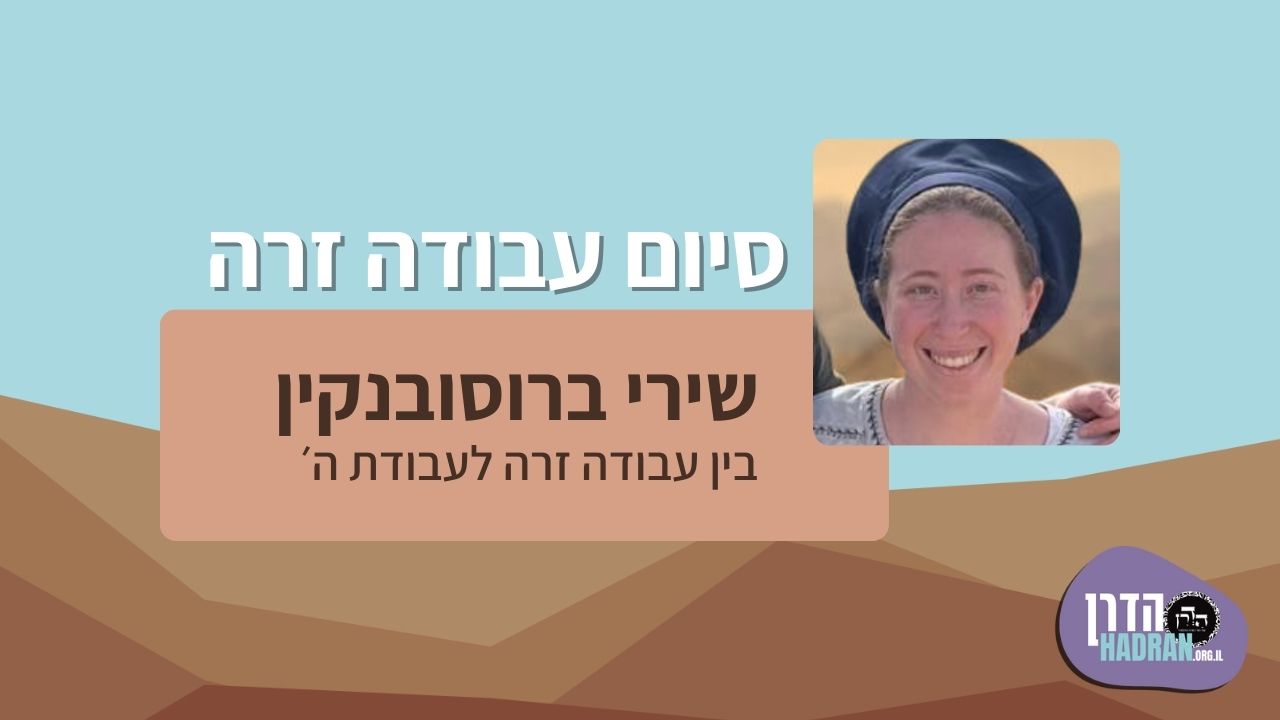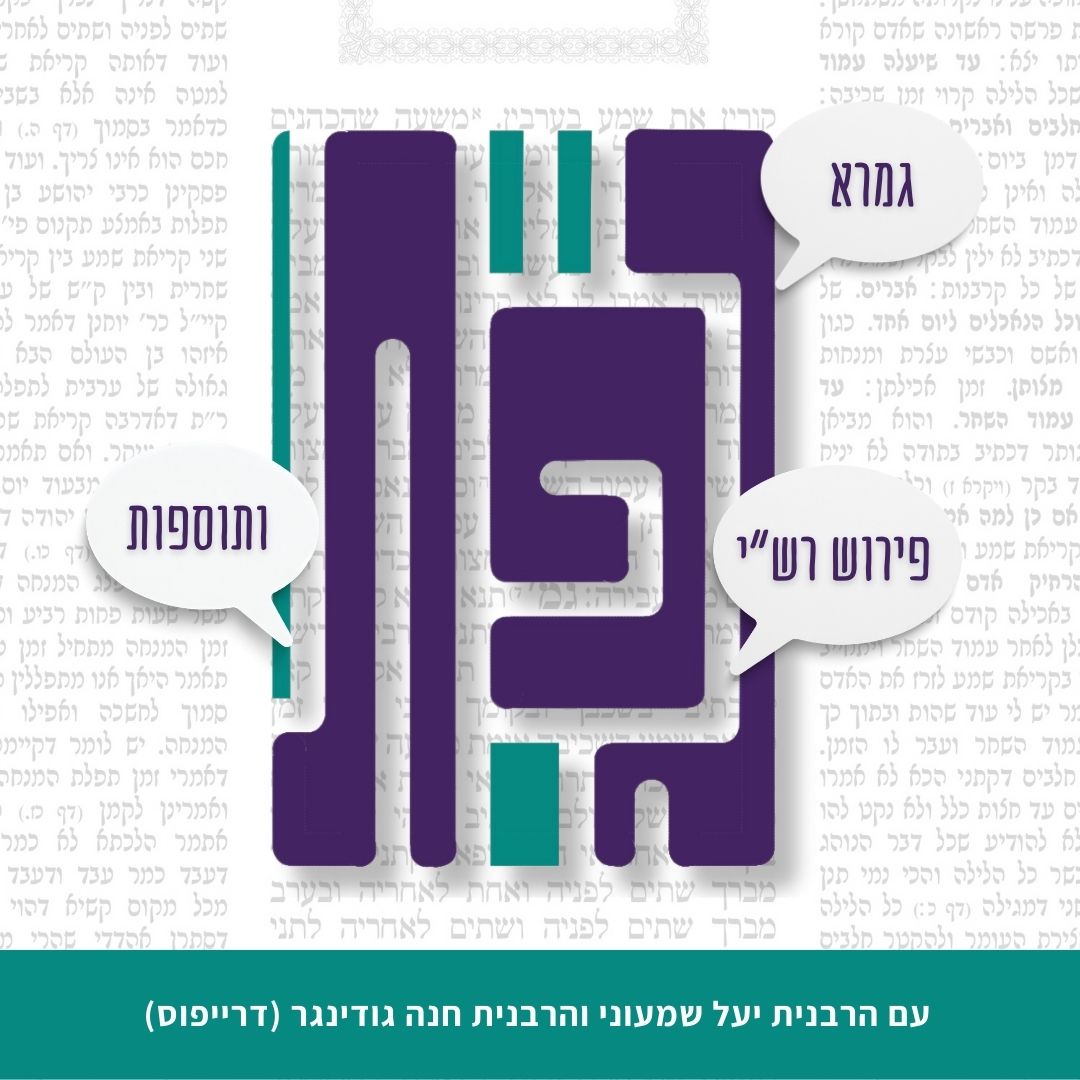הלימוד החודש מוקדש לעילוי נשמת הרב ד”ר ריימונד הררי ז”ל, לרגל היארצייט הראשון שלו. בתפקידו כמחנך וכמנהל ישיבה דפלטבוש וכרב קהילה, הוא השפיע על אלפים בחכמתו, בחמימותו, ובמחויבותו הבלתי מתפשרת לתורה.
רוצה להקדיש שיעור?
כלים
הלימוד החודש מוקדש לעילוי נשמת הרב ד”ר ריימונד הררי ז”ל, לרגל היארצייט הראשון שלו. בתפקידו כמחנך וכמנהל ישיבה דפלטבוש וכרב קהילה, הוא השפיע על אלפים בחכמתו, בחמימותו, ובמחויבותו הבלתי מתפשרת לתורה.
כלים
העמקה
רוצה להבין מה באמת קורה מתחת לפני השטח של הסוגיה?
שיעורים, פודקאסטים והרחבות של מיטב המורות שלנו יפתחו לך עוד זוויות וכיווני חשיבה.
חדשה בלימוד הגמרא?
זה הדף הראשון שלך? איזו התרגשות עצומה! יש לנו בדיוק את התכנים והכלים שיעזרו לך לעשות את הצעדים הראשונים ללמידה בקצב וברמה שלך, כך תוכלי להרגיש בנוח גם בתוך הסוגיות המורכבות ומאתגרות.
פסיפס הלומדות שלנו
גלי את קהילת הלומדות שלנו, מגוון נשים, רקעים וסיפורים. כולן חלק מתנועה ומסע מרגש ועוצמתי.
עבודה זרה מ״ז
אֲבָל עִיבְּרוּ וּלְבַסּוֹף נִרְבְּעוּ — דִּבְרֵי הַכֹּל אֲסוּרִין, וְהָכָא נָמֵי כְּעִיבְּרוּ וּלְבַסּוֹף נִרְבְּעוּ דָּמֵי.
But if they became pregnant and later a person engaged in bestiality with them, all agree that the offspring are forbidden because the offspring were involved in the act of bestiality, albeit in their fetal state. And here too, the case of the wheat is similar to the case where they became pregnant and later a person engaged in bestiality with them, because the flour was also worshipped, albeit in the form of a stalk of wheat.
אִיכָּא דְּאָמְרִי: מַחְלוֹקֶת כְּשֶׁנִּרְבְּעוּ וּלְבַסּוֹף עִיבְּרוּ, אֲבָל עִיבְּרוּ וּלְבַסּוֹף נִרְבְּעוּ — דִּבְרֵי הַכֹּל אָסוּר, וְהָנֵי נָמֵי כִּי עִיבְּרוּ וּלְבַסּוֹף נִרְבְּעוּ דָּמֵי.
There are those who say that Mar Zutra himself quoted Rav Naḥman’s statement: The dispute is with regard to a case where it became prohibited to use the animals as offerings because a person engaged in bestiality with them and later they became pregnant. But if they became pregnant and later a person engaged in bestiality with them, all agree that the offspring are forbidden. And these stalks of wheat, as well, are similar to the case where they became pregnant and later a person engaged in bestiality with them.
הָכִי הַשְׁתָּא? הָתָם, מֵעִיקָּרָא בְּהֵמָה וְהַשְׁתָּא בְּהֵמָה, דַּשָּׁא הוּא דַּאֲחִידָא בְּאַנְפַּהּ. הָכָא, מֵעִיקָּרָא חִיטֵּי וְהַשְׁתָּא קִמְחָא.
The Gemara asks: How can these cases be compared? There, in the case of offspring that it is prohibited to bring as an offering, it was initially an animal, in its fetal state, and now it is still an animal. A fetus is treated as a full-fledged animal, and the opening of the womb is compared to a closed door that holds it in its place. Here, in the case of the flour, it was initially wheat and now it is flour; it is in a totally new form. Therefore, no proof can be derived from the mishna.
בָּעֵי רֵישׁ לָקִישׁ: הַמִּשְׁתַּחֲוֶה לַדֶּקֶל, לוּלָבוֹ מַהוּ לְמִצְוָה?
§ Reish Lakish raises a dilemma: In the case of one who bows to a palm tree, what is the halakha with regard to its lulav? Is it permitted to use a lulav cut from it for the mitzva or not?
בְּאִילָן שֶׁנְּטָעוֹ מִתְּחִלָּה לְכָךְ לָא תִּיבְּעֵי לָךְ, דַּאֲפִילּוּ לְהֶדְיוֹט נָמֵי אָסוּר. כִּי תִּיבְּעֵי לָךְ בְּאִילָן שֶׁנְּטָעוֹ וּלְבַסּוֹף עֲבָדוֹ.
The Gemara narrows down the dilemma: With regard to a tree that one initially planted for such an idolatrous purpose, do not raise the dilemma. In that case the halakha is clear, as it is prohibited to use it even for an ordinary, non-mitzva, purpose. Rather, raise the dilemma with regard to a tree that one planted and subsequently worshipped.
וְאַלִּיבָּא דְּרַבִּי יוֹסֵי בַּר יְהוּדָה לָא תִּיבְּעֵי לָךְ, דַּאֲפִילּוּ לְהֶדְיוֹט נָמֵי אָסוּר. כִּי תִּיבְּעֵי לָךְ אַלִּיבָּא דְּרַבָּנַן, לְעִנְיַן מִצְוָה מַאי? מִי מְאִיס כְּלַפֵּי גָּבוֹהַּ אוֹ לָא?
And do not raise the dilemma according to the opinion of Rabbi Yosei bar Yehuda, who holds that even for an ordinary purpose it is forbidden (see 45b). Rather, when should you raise the dilemma? Raise it according to the opinion of the Rabbis, who hold that such a tree does not become forbidden: What is the halakha with regard to using a lulav from such a worshipped tree for a mitzva? Is it nevertheless forbidden because it is considered repulsive to use such a lulav for the Most High, i.e., for a mitzva, or not?
כִּי אֲתָא רַב דִּימִי אָמַר: בַּאֲשֵׁירָה שֶׁבִּיטְּלָהּ קָמִבַּעְיָא לֵיהּ, יֵשׁ דִּחוּי אֵצֶל מִצְוֹת אוֹ אֵין דִּחוּי אֵצֶל מִצְוֹת?
When Rav Dimi came from Eretz Yisrael to Babylonia, he presented a different understanding of Reish Lakish’s dilemma. He said: Reish Lakish raises the dilemma with regard to an ashera whose status as an object of idol worship was revoked. His dilemma is as follows: Is there disqualification with regard to mitzvot or is there no disqualification with regard to mitzvot? This lulav was once unfit for the mitzva, since it was worshipped while attached to the tree. Is it permanently disqualified, i.e., can it never be rendered fit? Or is the halakha that there is no permanent disqualification with regard to mitzvot, and consequently when the tree’s status as an object of idol worship was revoked, the lulav became fit for the mitzva?
תִּפְשׁוֹט לֵיהּ מִדִּתְנַן: כִּיסָּהוּ וְנִתְגַּלָּה — פָּטוּר מִלְּכַסּוֹת, כִּיסָּהוּ הָרוּחַ — חַיָּיב לְכַסּוֹת. וְאָמַר רַבָּה בַּר בַּר חָנָה אָמַר רַבִּי יוֹחָנָן: לֹא שָׁנוּ אֶלָּא שֶׁחָזַר וְנִתְגַּלָּה, אֲבָל לֹא חָזַר וְנִתְגַּלָּה — פָּטוּר מִלְּכַסּוֹת.
The Gemara suggests: Resolve the dilemma from that which we learned in a mishna (Ḥullin 37a): With regard to one who slaughtered an undomesticated animal or a bird and is obligated to cover the blood, if he covered the blood and it was then uncovered he is exempt from the obligation to cover it a second time. But if the wind blew dust and covered the blood and no person was involved, he is obligated to cover it. And Rabba bar bar Ḥana says that Rabbi Yoḥanan says: The mishna taught that one is obligated to cover the blood after the wind covered it only in a case where the blood was then exposed. But if it was not then exposed, he is exempt from the obligation to cover it.
וְהָוֵינַן בָּהּ: כִּי חָזַר וְנִתְגַּלָּה מַאי הָוֵי? הוֹאִיל וְאִידְּחִי אִידְּחִי!
And we discussed this issue and asked: When the blood was then exposed, what of it? Why is one obligated to cover it a second time? Once it was disqualified, it should remain disqualified. When the wind covered the blood, the person was exempted from covering the blood. If so, even if the blood is subsequently uncovered, he should remain exempt. Why, then, is he obligated to cover the blood in that case?
וְאָמַר רַב פָּפָּא, זֹאת אוֹמֶרֶת: אֵין דִּיחוּי אֵצֶל מִצְוֹת.
And Rav Pappa says: That is to say that there is no disqualification with regard to mitzvot. Once the cause of the exemption from the obligation is removed, one is once again obligated to fulfill the mitzva. If so, Reish Lakish’s dilemma is resolved.
דְּרַב פָּפָּא גּוּפֵיהּ אִיבַּעְיָא לֵיהּ, מִפְשָׁט פְּשִׁיטָא לֵיהּ לְרַב פָּפָּא דְּאֵין דִּיחוּי אֵצֶל מִצְוֹת, לָא שְׁנָא לְקוּלָּא וְלָא שְׁנָא לְחוּמְרָא.
The Gemara rejects this suggestion: It is with regard to Rav Pappa’s resolution itself that Reish Lakish raised the dilemma. Is it obvious to Rav Pappa, based on the discussion with regard to the blood, that there is no disqualification with regard to mitzvot; and there is no difference whether that ruling leads to leniency, as in the case of the worshipped tree whose status as an object of idol worship was revoked, thereby permitting its lulav branch to be used for a mitzva, and there is no difference whether that ruling leads to stringency, as in the case of the blood, where one is obligated to cover it anew?
אוֹ דִלְמָא סַפּוֹקֵי מְסַפְּקָא לֵיהּ, וּלְחוּמְרָא אָמְרִינַן, לְקוּלָּא לָא אָמְרִינַן? תֵּיקוּ.
Or perhaps is he uncertain, and therefore, when that ruling leads to stringency, we say that there is no disqualification with regard to mitzvot, and one must perform the mitzva. But when that ruling leads to leniency, we do not say that there is no disqualification with regard to mitzvot. The Gemara concludes: The question shall stand unresolved.
בָּעֵי רַב פָּפָּא: הַמִּשְׁתַּחֲוֶה לִבְהֵמָה, צַמְרָהּ מַהוּ לִתְכֵלֶת?
§ Rav Pappa raises a dilemma: In the case of one who bows to an animal, what is the halakha with regard to its wool? May it be used for the sky-blue wool?
תְּכֵלֶת דְּמַאי? אִי תְּכֵלֶת לְכֹהֲנִים — הַיְינוּ בַּעְיָא דְּרָמֵי בַּר חָמָא, וְאִי תְּכֵלֶת לְצִיצִית — הַיְינוּ בַּעְיָא דְּרֵישׁ לָקִישׁ!
The Gemara asks: The sky-blue wool in question is for which mitzva? If it is the sky-blue wool for the ritual garments worn by priests, then Rav Pappa’s dilemma is the same as the dilemma raised by Rami bar Ḥama earlier (46b) with regard to the use in the Temple of worshipped items that have since changed in form. And if the sky-blue wool in question is for the mitzva of ritual fringes, this is the same as the dilemma raised by Reish Lakish with regard to the use of a branch of a worshipped palm tree for performing the mitzva of lulav.
אִין הָכִי נָמֵי דְּלָא הֲוָה לְמִיבְּעֵי לֵיהּ, וְהַאי דְּקָא בָעֵי לֵיהּ הָא מִשּׁוּם דְּאִיכָּא מִילֵּי אַחְרָנְיָיתָא: צַמְרָהּ מַהוּ לִתְכֵלֶת? קַרְנֶיהָ מַהוּ לַחֲצוֹצְרוֹת? שׁוֹקֶיהָ מַהוּ לַחֲלִילִין? בְּנֵי מֵעֶיהָ מַהוּ לְפֹארוֹת?
The Gemara answers: Yes, it is indeed so that Rav Pappa did not need to raise this dilemma, as it was previously addressed. And the reason that he raises this dilemma is due to other matters that he needed to clarify, concerning the use of parts of a worshipped animal in the Levites’ ritual song. With regard to its wool, what is the halakha concerning using it for sky-blue wool used in the performance of a mitzva? With regard to its horns, what is the halakha concerning their use for trumpets? With regard to the bones of its thighs, what is the halakha concerning their use for flutes? With regard to its innards, what is the halakha concerning their use for harp strings [leforot]?
אַלִּיבָּא דְּמַאן דְּאָמַר: עִיקַּר שִׁירָה בִּכְלִי, לָא תִּיבְּעֵי לָךְ — דְּוַדַּאי אֲסִיר.
According to the opinion of the one who says that the primary element of song in the Temple is the accompaniment by musical instruments, do not raise the dilemma, as it is certain that use of a worshipped animal is prohibited, because the musical instruments are items used to facilitate an offering.
כִּי תִּיבְּעֵי לָךְ, אַלִּיבָּא דְּמַאן דְּאָמַר: עִיקַּר שִׁירָה בַּפֶּה, בַּסּוֹמֵי קָלָא בְּעָלְמָא הוּא וּמַיְיתִינַן, אוֹ דִלְמָא אֲפִילּוּ הָכִי אֲסִיר? תֵּיקוּ.
When should you raise the dilemma? Raise it according to the opinion of the one who says that the primary element of song in the Temple is singing with the mouth, and that the musical instruments are used merely to sweeten the sound, i.e., to accompany and enhance the singing. And accordingly, can one bring musical instruments made of a worshipped animal’s parts, as they are not an essential element of the Temple service? Or perhaps is it nevertheless forbidden since it is repulsive to use such instruments in the course of the Temple service? The Gemara concludes: The question shall stand unresolved.
בָּעֵי רַבָּה: הַמִּשְׁתַּחֲוֶה לְמַעְיָן, מֵימָיו מַהוּ לִנְסָכִים? מַאי קָא מִיבַּעְיָא לֵיהּ? אִילֵּימָא לְבָבוּאָה קָא סָגֵיד, אוֹ דִלְמָא לְמַיָּא קָא סָגֵיד? וְתִיבְּעֵי לֵיהּ סֵפֶל לְהֶדְיוֹט!
§ Rava raises a dilemma: In the case of one who bows to a spring of water, what is the halakha with regard to using its water for libations? The Gemara asks: What is the dilemma he is raising? If we say that the dilemma concerns whether he is bowing to his own reflection or perhaps he is bowing to the water, why then is this a dilemma only with regard to libations in the Temple? Let him raise the dilemma with regard to the use of a pail of water that a person bowed to, even for ordinary purposes.
לְעוֹלָם לְמַיָּא קָא סָגֵיד, וְהָכִי קָמִבַּעְיָא לֵיהּ: לְמַיָּא דְּקַמֵּיהּ קָא סָגֵיד, וְקַמָּאֵי קַמָּאֵי אֲזַדוּ, אוֹ דִּלְמָא לְדַבְרוּנָא דְּמַיָּא קָא סָגֵיד?
The Gemara answers: Actually, it is clear that he is bowing to the water. And this is the dilemma Rava raises: Is he bowing to the water before him, and therefore it follows that the first waters, i.e., those that were present at the time of his bowing, are gone, and the water that is currently flowing is permitted, or perhaps is he bowing to the flow of the water, which would render it prohibited to use all the water that flows in that spring for libations.
וּמִי מִיתַּסְרִי? וְהָא אָמַר רַבִּי יוֹחָנָן מִשּׁוּם רַבִּי שִׁמְעוֹן בֶּן יְהוֹצָדָק: מַיִם שֶׁל רַבִּים אֵין נֶאֱסָרִין! לָא צְרִיכָא, דְּקָא נָבְעִי מֵאַרְעָא.
The Gemara asks: And is the water actually rendered forbidden by his worship? But doesn’t Rabbi Yoḥanan say in the name of Rabbi Shimon ben Yehotzadak: Water that belongs to the public cannot become forbidden? The Gemara answers: No, the dilemma is not with regard to a public spring. Rather, it is necessary with regard to a spring that flows from the ground in one specific location that is privately owned.
מַתְנִי׳ מִי שֶׁהָיָה בֵּיתוֹ סָמוּךְ לַעֲבוֹדָה זָרָה, וְנָפַל — אָסוּר לִבְנוֹתוֹ. כֵּיצַד יַעֲשֶׂה? כּוֹנֵס בְּתוֹךְ שֶׁלּוֹ אַרְבַּע אַמּוֹת וּבוֹנֶה.
MISHNA: In the case of one whose house was adjacent to a house of idol worship and the dividing wall fell, it is prohibited to rebuild it. What should he do? He should withdraw into his own property four cubits and build the wall there.
שֶׁלּוֹ וְשֶׁל עֲבוֹדָה זָרָה —
In talmudic times, external walls to homes were often built in two parts, with a functional space between them. If the space between the two parts of the wall belonged to him and to the house of idol worship,
נִידּוֹן מֶחֱצָה עַל מֶחֱצָה.
the area is treated as half and half with regard to withdrawing into his property before rebuilding the wall; he may build the wall four cubits from the middle of that space.
אֲבָנָיו, עֵצָיו וַעֲפָרוֹ — מְטַמְּאִין כְּשֶׁרֶץ, שֶׁנֶּאֱמַר: ״שַׁקֵּץ תְּשַׁקְּצֶנּוּ״.
The stones of the fallen wall, its wood, and its dust, transmit impurity like a creeping animal, i.e., one who touches them becomes impure like one who touches a creeping animal, as it is stated: “And you shall not bring an abomination into your house, and be accursed like it; you shall detest it [shakketz teshakketzennu], and you shall abhor it; for it is a proscribed item” (Deuteronomy 7:26). The term shakketz is used in a different form, shekketz, with regard to creeping animals.
רַבִּי עֲקִיבָא אוֹמֵר: כְּנִדָּה, שֶׁנֶּאֱמַר: ״תִּזְרֵם כְּמוֹ דָוָה צֵא תֹּאמַר לוֹ״, מָה נִדָּה מְטַמְּאָה בְּמַשָּׂא, אַף עֲבוֹדָה זָרָה מְטַמְּאָה בְּמַשָּׂא.
Rabbi Akiva says: Those items transmit impurity like a menstruating woman, as it is stated: “You will put them far away as a menstruating woman; you shall say to it: Go away” (Isaiah 30:22). Just as a menstruating woman transmits impurity by carrying, as one who moves a menstruating woman, even without touching her, becomes impure, so too, objects of idol worship transmit impurity by carrying.
גְּמָ׳ וְהָא קָא מַרְוַוח לַעֲבוֹדָה זָרָה! אָמַר רַב חֲנִינָא מִסּוּרָא: דְּעָבֵד לֵיהּ בֵּית הַכִּסֵּא.
GEMARA: The mishna teaches that one must rebuild his wall at a distance from the house of idol worship. The Gemara asks: But how may one do so? Isn’t he creating more space for the house of idol worship? Rav Ḥanina of Sura said: This is not a problem, as he converts the empty space into a bathroom.
וְהָא בָּעֵי צְנִיעוּתָא! דְּעָבֵד לֵיהּ בֵּית הַכִּסֵּא דְּלַיְלָה.
Since the mishna teaches that no wall may be built in that space, the bathroom is apparently not enclosed. The Gemara asks: But doesn’t a bathroom need to be in a place of modesty? The Gemara answers: This is not a problem, as he converts it into a bathroom for nighttime, when no one can see him.
וְהָא אָמַר מָר: אֵיזֶהוּ צָנוּעַ? הַנִּפְנֶה בַּלַּיְלָה בְּמָקוֹם שֶׁנִּפְנָה בַּיּוֹם, וְאַף עַל גַּב דְּאוֹקֵימְנָא בִּכְדֶרֶךְ, מִיהוּ צְנִיעוּתָא בָּעֵי לְמֶעְבַּד!
The Gemara asks: But didn’t the master say in a baraita: Who is a modest person? One who defecates at night in the same place that he defecates during the day, i.e., in a place where no one can see him? And although we interpreted the baraita as referring not to location but to conduct, teaching that one must conduct himself at night in the same manner, i.e., with the same degree of modesty, as he does during the day with regard to removing his clothing when defecating (see Berakhot 62a), nevertheless, it can be inferred from here that even at night one is required to observe the dictates of modesty.
דְּעָבֵד לֵיהּ לְתִינוֹקוֹת.
The Gemara answers: This is not a problem, as he converts it into a bathroom for children, who are not required to observe the same level of modesty.
אִי נָמֵי, דְּגָדַיר לֵיהּ בְּהִיזְמֵי וְהִיגֵי.
The Gemara suggests a different answer to the problem of enlarging the space used for idolatry: Alternatively, one can answer that he fences in the four-cubit space with thorns and shrubs, thereby preventing its use.
מַתְנִי׳ שְׁלֹשָׁה בָּתִּים הֵן — בַּיִת שֶׁבְּנָאוֹ מִתְּחִלָּה לַעֲבוֹדָה זָרָה, הֲרֵי זֶה אָסוּר. סִיְּידוֹ וְכִיְּידוֹ לַעֲבוֹדָה זָרָה וְחִידֵּשׁ — נוֹטֵל מַה שֶּׁחִידֵּשׁ. הִכְנִיס לְתוֹכָהּ עֲבוֹדָה זָרָה וְהוֹצִיאָהּ — הֲרֵי זֶה מוּתָּר.
MISHNA: With regard to idol worship there are three types of houses, each with its own halakhot. A house that one built initially for the purpose of idol worship is forbidden, i.e., it is prohibited to derive benefit from such a house. If one plastered a house or cemented it for the purpose of idol worship, and he thereby added a layer to the walls of the house, one removes that which he added, and the rest of the house is permitted. If one brought an object of idol worship into a house temporarily and then removed it, the house is then permitted.
גְּמָ׳ אָמַר רַב: הַמִּשְׁתַּחֲוֶה לְבַיִת — אֲסָרוֹ. אַלְמָא קָסָבַר תָּלוּשׁ וּלְבַסּוֹף חִבְּרוֹ כְּתָלוּשׁ דָּמֵי, וְהָאֲנַן ״בְּנָאוֹ״ תְּנַן!
GEMARA: Rav says: One who bows to a house has rendered it forbidden. The Gemara infers: Evidently, Rav holds that an item that was detached and that one subsequently attached is considered as if it were still detached. Consequently, a house, which is attached to the ground but was built with materials that were detached from the ground, can become forbidden through worship. The Gemara asks: But didn’t we learn in the mishna that if a house was initially built for the purpose of idol worship, it is forbidden? This indicates that the house becomes forbidden only when it is initially constructed for idolatrous purposes.
בְּנָאוֹ — אַף עַל פִּי שֶׁלֹּא הִשְׁתַּחֲוָה לוֹ, הִשְׁתַּחֲוָה — אַף עַל פִּי שֶׁלֹּא בְּנָאוֹ. אִי הָכִי, הָנֵי שְׁלֹשָׁה — אַרְבָּעָה הָווּ!
The Gemara answers that there are two cases where the house is rendered forbidden: If one built it for purposes of idol worship, even if he did not bow to it, or if he bowed to it, even if he did not build it for purposes of idol worship; it is forbidden in either case. The Gemara asks: If so, why does the mishna list only these three types of houses, when there are really four?
כֵּיוָן דִּלְעִנְיַן בִּיטּוּל, בָּנָה וְהִשְׁתַּחֲוָה חַד קָא חָשֵׁיב לֵיהּ.
The Gemara answers: Since with regard to the revocation of their idolatrous status there is no difference between a house that one built for idolatrous purposes and a house that one bowed down to, the mishna considers them as one.
מַתְנִי׳ שָׁלֹשׁ אֲבָנִים הֵן — אֶבֶן שֶׁחֲצָבָהּ מִתְּחִלָּה לְבִימוֹס — הֲרֵי זוֹ אֲסוּרָה. סִיְּידָהּ וְכִיְּידָהּ לְשֵׁם עֲבוֹדָה זָרָה — נוֹטֵל מַה שֶׁסִּיֵּיד וְכִיֵּיד, וּמוּתֶּרֶת. הֶעֱמִיד עָלֶיהָ עֲבוֹדָה זָרָה וְסִילְּקָהּ — הֲרֵי זוֹ מוּתֶּרֶת.
MISHNA: With regard to idol worship there are three types of stones, each with its own halakhot. A stone that one initially hewed for use in a platform [bimos] for an idol is forbidden. If one plastered a stone or cemented it for the sake of idol worship, one removes that which he plastered or cemented and the stone is permitted. If one erected an object of idol worship upon a stone and subsequently removed it, the stone is then permitted.
גְּמָ׳ אָמַר רַבִּי אַמֵּי: וְהוּא שֶׁסִּיֵּיד וְכִיֵּיד בְּגוּפָהּ שֶׁל אֶבֶן.
GEMARA: The mishna teaches that one may not derive benefit from a stone plastered or cemented for the sake of idol worship. Rabbi Ami says: And that is the halakha provided that one plastered or cemented within the stone itself, by carving or engraving into it. If the plaster or cement was merely appended to the outside of the stone as an external ornament, the stone is not forbidden.
וְהָא דֻּומְיָא דְּבַיִת תְּנַן, וּבַיִת לָאו בְּגוּפֵיהּ הוּא, וּמִיתְּסַר! בַּיִת נָמֵי אִיכָּא בֵּינֵי אוּרְבֵי.
The Gemara asks: But didn’t we learn in the mishna the halakha with regard to stones immediately following the halakha with regard to a house utilized for idol worship? This indicates that the halakha of a stone is similar to the halakha of a house. And in the case of a house that was rendered forbidden when it was plastered or cemented for idol worship, that plastering was not done within the house itself, but on the exterior of its walls, and even so it is rendered forbidden. Accordingly, even external plastering should render the stone forbidden. The Gemara answers: In the case of a house it can also be explained that the plaster or cement was added to the house itself, as there is space in between the bricks that can be filled in.
מִי לָא עָסְקִינַן דְּשִׁייעַ, וַהֲדַר שַׁיְיעֵיהּ?
The Gemara asks: As the mishna does not specify, are we not dealing even with a house that one plastered with no idolatrous purpose and then plastered again on top of that layer for the sake of idol worship, rendering the house forbidden even without affecting the house itself?
אֶלָּא כִּי אִתְּמַר דְּרַבִּי אַמֵּי — לְעִנְיַן בִּיטּוּל אִתְּמַר, וְאַף עַל גַּב דְּסִיֵּיד וְכִיֵּיד בְּגוּפָהּ שֶׁל אֶבֶן, כִּי נָטַל מַה שֶּׁחִידֵּשׁ — שַׁפִּיר דָּמֵי.
The Gemara answers: Rabbi Ami was not explaining at what point a stone plastered for idolatry becomes forbidden; rather, when Rabbi Ami’s statement was stated, it was stated with regard to revocation of the stone’s idolatrous status, and he taught that even if one plastered or cemented within the stone itself, when one removes that which was added, it is permitted.
דְּמַהוּ דְּתֵימָא: כֵּיוָן שֶׁסִּיֵּיד וְכִיֵּיד בְּגוּפָהּ שֶׁל אֶבֶן, כְּאֶבֶן שֶׁחֲצָבָהּ מִתְּחִלָּה לַעֲבוֹדָה זָרָה דָּמְיָא, וְתִיתְּסַר כּוּלַּהּ, קָא מַשְׁמַע לַן.
The Gemara explains Rabbi Ami’s ruling: Lest you say that since one plastered or cemented within the stone itself, it is equivalent to a stone that one initially hewed for idol worship, and therefore the entire stone is forbidden, Rabbi Ami teaches us that the stone can become permitted by the removal of the additional layer of plaster.





















